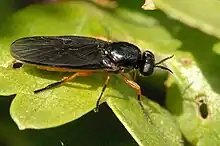| Beris clavipes | |
|---|---|
 | |
| Beris clavipes | |
| Scientific classification | |
| Domain: | Eukaryota |
| Kingdom: | Animalia |
| Phylum: | Arthropoda |
| Class: | Insecta |
| Order: | Diptera |
| Family: | Stratiomyidae |
| Subfamily: | Beridinae |
| Genus: | Beris |
| Species: | B. clavipes |
| Binomial name | |
| Beris clavipes | |
| Synonyms | |
Beris clavipes, the scarce orange legionnaire, is a European (Northern and central Europe down into France, towards north to middle Sweden) species of soldier fly.[2][3][4]
Description
Length 6—6.3 mm. Male. Eyes hairy, facets in about the upper two thirds larger than below. Antennae black, the first joint longer than the second. Thorax black with blackish pubescence. Abdomen orange with brownish pubescence, which is long at the margin: the base brown; on the second to sixth segment the transverse, impressed line just in front of the hind margin is more or less distinctly blackish: the seventh segment is not brown. Venter yellowish red. Legs yellow; the apical half of the anterior tibiae, the hind tibiae at the tips and all tarsi blackish:the hind metatarsi much thickened. Legs with fine, yellowish pubescence. Wings considerably brownish and more so than in vallata especially towards the anterior margin, veins brown: stigma not conspicuous. Halteres brownish.
Female. Eyes sparingly and very short hairy. Frons broad, black. Thorax with brown pubescence. Abdomen not brown at the base: wings nearly as brown as in the male.[5][6][7][8]

Biology
The habitat is wetland and flowing water locations with trees and shrubs. Adults are found from April to September.The larvae are found in wet moss.
Distribution
Austria, Belgium, Bulgaria, Czech Republic, Denmark, Finland, England, Estonia, Finland, France, Georgia, Germany, Hungary, Iceland, Ireland, Italy, Latvia, Lithuania, Netherlands, Norway, Poland, Romania, Russia, Slovakia, Spain, Sweden, Switzerland, Ukraine
References
- 1 2 Linnaeus, C. (1767). Systema naturae ... Ed. 12 (revised.) Vol. 1 (2). Holmiae [= Stockholm]: L.Salvii. pp. 533-1327 + [37] pp.
- ↑ Stubbs, Alan E; Drake, Martin (2014). British Soldierflies and their allies (an illustrated guide to their identification and ecology) (2 ed.). Reading: British Entomological and Natural History Society. pp. 528 pp, 20 plates. ISBN 9781899935079.
- ↑ Woodley, N.E. (2001). "A World Catalog of the Stratiomyidae (Diptera)" (PDF). Myia. 11: 1–462. Retrieved 7 December 2022.
- ↑ Zeegers, T.; Schulten, A. (2022). Families of Flies with Three Pulvilli: Field Guide Northwest Europe. Graveland: Jeugdbondsuitgeverij. pp. 256pp. ISBN 9789051070682.
- ↑ William Lundbeck Diptera Danica. Genera and species of flies Hitherto found in Denmark. Copenhagen & London, 1902-1927. 7 vols
 This article incorporates text from this source, which is in the public domain.
This article incorporates text from this source, which is in the public domain. - ↑ George Henry VerrallStratiomyidae and succeeding families of the Diptera Brachycera of Great Britain- British flies (1909)BHL Full text with illustrations
- ↑ Verrall, G. H., 1909 Stratiomyidae and succeeding families of the Diptera Brachycera of Great Britain British flies Volume 5 London : Gurney and Jackson, 1909.BHL Full text with illustrations
- ↑ E. P. Narchuk in Bei-Bienko, G. Ya, 1988 Keys to the insects of the European Part of the USSR Volume 5 (Diptera) Part 2 English edition. Keys to Palaearctic species but now needs revision.